WATERSOUND LIFESTYLE

a timeless family tradition









a timeless family tradition







Here, vast, uninterrupted stands of pine trees carpet a bountiful watershed laced with trickles, tributaries and creeks drawn to pristine bays and the Gulf of Mexico, with its turquoise water and white-sand beaches. There are signs of human activity, but of a low-impact sort. A broadening system of transecting trails attract hikers who thrill at the site of a majestic eagle, a keening osprey or a bounding white-tail. This is an area, smack in the middle of the “Real Florida,” whose appeal is timeless and whose character commands reverence. Here, people and the natural world engage in a peaceful kind of cohabitation.
Welcome to the Watersound community, whose residents and visitors are united by a connection to place. It is the product of a carefully measured effort not to overtake an environment, but to merge with it. It is the result of a vision that has given rise to neighborhoods and places to play and personal recharging stations for people at all stages of their lives.
The Watersound community’s gathering places are concentrated at the perimeter of more than 100,000 idyllic acres that encompass large parts of Florida’s Bay and Walton counties. Nearly half of this acreage has been set aside for longterm conservation, ensuring that the Watersound community’s essential, natural character will remain undisturbed for generation after generation.
Our neighborhoods, tourist destinations and the community assets that support them are coming about in concert. There is much growth to come, but all of it will be consistent with a commitment to blend in with the surroundings as they were found.
The Watersound community offers single-family homes, apartments, townhomes and a senior independent living community; well suited to young professionals, new families and the parents of grown children.

THE WATERSOUND COMMUNITY IS HERE



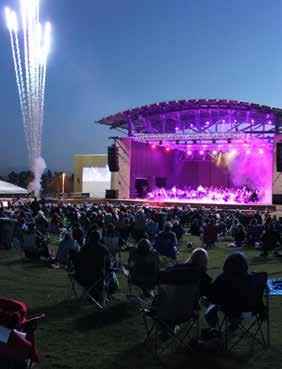

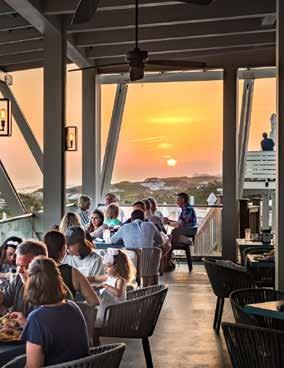

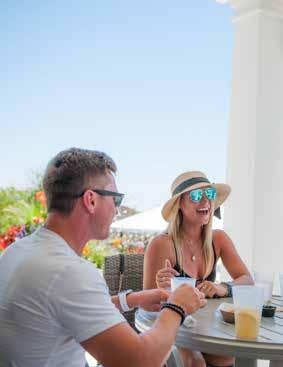


Retailers and restaurants are setting up shop in our town centers. Commerce parks and professional office spaces are attracting businesses with sights set on the future. The region is served by Northwest Florida Beaches International Airport which is continuously expanding and has direct flights throughout the Southeast and beyond. Already, medical professionals are providing excellent health care at primary care centers. More specialists are coming and construction of the FSU Health Medical Campus has begun.
For many, stays at welcoming inns and resorts like WaterColor Inn or TownePlace Suites serve as their introduction to the Watersound community and its many recreational options. For those seeking the country’s best golf, beach and lifestyle amenities, the private Watersound Club membership blends memories, luxury and approachability at its growing list of venues.
Among visitors, more than a few will choose to make the Watersound community their permanent home. The area is home to top-ranked public and charter schools. Florida offers an outstanding business climate. And the weather and the water are fine, keeping to three seasons as we skip harsh winters.

Not surprisingly, the Watersound community proves conducive to artists and the arts. Along the Watersound Monarch Art Trail, Jonathan Burger’s “Kaleidoscope” represents the capacity of people to pool their resources and help each other. An apt description of the Watersound community, a place where people take an interest in one another, a safe place where children can comfortably explore their environment.
It’s a place where making connections is effortless — connections to the land and its waterways coupled with an unmistakable sense of peace that feels like home. For those who visit and those who never leave, the connections are intimate and last a lifetime.

For those who visit and those who never leave, the connections are intimate and last a lifetime.OPPOSITE PAGE Top Row : Watersound Town Center Pavilion, Watersound Beach Club, Panama City Beach Conservation Park. Middle Row: Watersound Bonfire, Gulf of Mexico, Watersound Beach Club. Bottom Row: Aaron Bessant Park, Shark’s Tooth Golf Course, Fish Out of Water Restaurant. THIS PAGE Watersound Origins Community, Watersound Monarch Art Trail.





PUBLICATION DESIGN, PRODUCTION AND MANAGEMENT
CONTRIBUTING WRITERS
PAIGE AIGRET
KARI C. BARLOW
BEN BLALOCK
CARRIE HONAKER
BARRY WEBB
VICKI BURRIS
CONTRIBUTING PHOTOGRAPHERS
BRANDAN BABINEAUX
MANDY JOHNSON PHOTOGRAPHY
KURT LISCHKA COLLIS THOMPSON
WATERSOUNDCLUB.COM

MEMBERSHIP OFFICE
850.213.5181

20
Abound Camp Creek updates come to fruition with expansive fitness, sports and swimming amenities. 28 Coastal Ecology Q&A Club Member Dr. Jon Schmidt discusses his weekly summer class at the Beach Club.

54 A Community Hub Point South Marina at Port St. Joe welcomes families back to this Forgotten Coast launching point.
58 A Scalloping Haven
Shallow, crystal-clear waters of St. Joseph Bay create a scalloping hot spot, a welcome activity for all ages.
68 Partners in Marine Education St. Joe and Guy Harvey foundations team up to bring ocean life to classrooms.
74 Preserve to Persist
The St. Joe Company makes environmental conservation a top priority, focusing on longterm sustainability.





Club memberships enliven the Emerald Coast lifestyle

Dear Members and Friends of Watersound Club,

It is such a pleasure to introduce the latest edition of Watersound Lifestyle magazine. With spring in the air and summer just around the corner, we are finding it easier than ever to appreciate the things that make the Watersound Club experience so special. As Watersound Club Members and staff, we form a community that offers a gracious sanctuary where friendships are formed and cemented and a wide array of activities help engender a true sense of camaraderie.
In this issue of Watersound Lifestyle magazine, we introduce you to our aptly titled director of fun, Andy Nelson. Known affectionately as our “king of games,” Andy possesses the ability to create special occasions on any day of the week and act as a ringleader for Members who are out to have fun! Whether he’s bringing his overthe-top energy and humor to a themed night of trivia or finding a way to help our young Members make memories that last a lifetime, Andy truly puts his heart into everything he does.
You’ll also get a chance to learn how Dr. Jon Schmidt, a Watersound Club Member and our favorite expert on our local marine ecosystem, makes learning fun; pick up a trick or two from our tennis and golf professionals; and read about why time spent together at the beach is the perfect way to make memories for the family of a fellow Member whose career keeps him in the spotlight.
Ready to expand your horizons and try a new activity this summer? Learn the ins and outs of scallop season in Port St. Joe in our spotlight on scalloping, or consider a new approach to travel aboard the Club’s private chartered plane.
Best of all, as we approach the grand opening of our new Watersound Club amenities, we’ll make sure you have a front seat to enjoy another perfect space for making memories.
On behalf of the entire Watersound Club team, thank you for choosing to be part of our Club family. Let’s make this season one to remember!
VICKI BURRIS WATERSOUND CLUB DIRECTOR OF MEMBERSHIP


 Written By KARI C. BARLOW
Written By KARI C. BARLOW
Since its inception, Watersound Club leadership has looked to its membership for cues on how to improve and expand lifestyle programming and amenities.
Prior to 2018, the Club conducted extensive Member surveys, and the findings all pointed in the same direction: wellness and fitness. Club staff embraced the feedback and ran with the idea, eventually finalizing plans for what has long been known as the “Camp Creek amenities expansion.”
“Members choose to spend their time with us, and we take seriously our responsibility to make sure that’s time well spent,” said Watersound Club membership director Vicki Burris. “We want to wow them. We want it to be worth the investment they have made in the Club.”
The sprawling collection of amenities includes a 12,000-squarefoot wellness center; a lazy river;

“You have to have something for every age level — for the kids all the way through to grandparents,” said Watersound Club director of wellness and outdoor pursuits Amy Robison. “We want to create something for the beginner. We want to create something for the advanced person who’s working out every day. It’s our challenge to come up with such a variety of options, but through regular classes and workshops, we want to cater to everyone.”
Robison expects the wellness center will initially host roughly 25 classes a week including a six-week yoga integration class with levels one and two and a four-week WOW (Women on Weights) class, as well as mat Pilates, high-intensity interval training and indoor cycling. Also happening in 2023 is a six-week “40 Days to Personal Revolution” class blending yoga, meditation, nutrition and self-inquiry.
“Geared toward all yogis, this program will leave you physically stronger, mentally clearer, healthier and empowered to live a better life,” Robison said.
On the first floor of the wellness center are locker rooms featuring saunas, steam rooms, Vichy showers and traditional showers. While cardio, strength machines, free weights and additional fitness studios are located on the second floor.
“I think yoga is going to be really popular because it can benefit every ability,” Robison said, adding that new pool classes using an inflatable fitness board should also be in demand. “It works a lot on your core and improving your balance. It’s a nice twist.”
an 80,000-gallon zero-entry pool with a 139-foot-long water slide; a fitness lawn for outdoor classes; eight new tennis courts and eight new pickleball courts; a 19-meter adult fitness pool; a playground for ages 2 to 12; a multiuse sports field; a teen game room; and a new casual dining restaurant.
Located adjacent to Camp Creek Golf Course, these new developments
The goal is to build upon the success of the fitness classes — yoga, HIIT and others — already being offered, Robison said.
“Month over month, we kept getting more people participating in our programs,” she said. “That’s one of the things that has been really fun. We’ve really started a great community of Members who didn’t know each other before, and now they’re becoming great friends.”
are poised to help radically expand the scope of Watersound Club amenities.

“It’s driven by the Members and what they said they wanted to see at their Club,” Burris said. “It’s a long time coming, and our Members have watched the dirt get pushed around and they’ve seen renderings, but they are excited that it’s actually coming to life.”
The goal of the Camp Creek expansion has always been to encourage healthy movement and joyful gathering among all Watersound Club Members.
“You’re nestled back into this beautiful environment,” Burris said. “It has that resort feel and Club environment where you know the
person in the chair beside you and you see them in the community, and you live life together.”
Excitement over the new wellness center — and the countless fitness opportunities it will bring — is at an all-time high among the adult Watersound Club Membership.
“They want to consolidate all those gym memberships into one,” Burris said. “They want a one-stop shop where all their wellness needs are taken care of.”
Amy Robison, Watersound Club director of wellness and outdoor pursuits, said the new wellness center reflects the healthy lifestyle that Club Members value.
“It’s a very active Club,” she said. “People want to get involved and they want to experience new things.” Robison anticipates the new yoga classes — held inside the new wellness center as well as in outside recreational areas — and water fitness in the adult pool will be wildly popular.
Among the community’s youngsters, the game room is generating major buzz.
“And they can’t wait to get down that big water slide,” Burris said. “A lot of summertime memories are going to be made at that pool area!”
For Members who enjoy dining and socializing in a relaxed setting, the new Bark ‘N Brine dining venue promises to be especially popular.
“We’ve really started a great community of Members who didn’t know each other before, and now they’re becoming great friends.”
—Amy Robison, Watersound Club director of wellness and outdoor pursuits.
With a vibe of casual elegance, an exposed-brick decor and a mix of indoor and outdoor seating, the eatery will serve up everything from healthy quinoa and mixed-green salads to delectable pulled pork and pimento cheese sandwiches. Located next to the wellness center and family pool, Bark ‘N Brine will feature a daily chalkboard menu curated by the Watersound Club culinary team.
Burris predicts that the entire amenities collection will not only thrill current Members, but will also help ensure that Watersound Club’s

private membership will continue to deliver a world-class experience well into the future.
“That has been our goal,” she said. “With the vast land holdings that St. Joe has, we want to be the premier club not just in the area, but anywhere in the country. We know this area will continue to grow and we want to be able to welcome those future Members and future neighbors. These are people we will be making happy memories with, so we want to accommodate them and have plenty of room for all of our Members by the pool!”
Watersound Club director of tennis Barry Webb is confident that the Club’s eight new tennis courts and eight new pickleball courts will be well used.
“This will be our hub now,” he said of the expanded complex built to host lessons, clinics, round robins and social mixers.
Webb is particularly excited about pickleball and its potential to draw more people to the courts and increase interaction among Members. Eight pickleball courts can facilitate play for 32 people at a time, allowing more year-round and seasonal opportunities to make connections. And Members will be able to shop for all their pickleball needs in the Club’s full-service pro shop.
“Since the pandemic, pickleball has really taken off,” Webb said. “It’s a little different. It’s a lot more social than tennis. Your tennis purists are pretty serious. There’s not a lot of chitchat going on during tennis matches.”
During pickleball, however, the banter flows.
“There’s laughing and picking on each other and sometimes there might be some adult beverages involved,” Webb said. “But it’s getting people moving, and it’s competitive!”


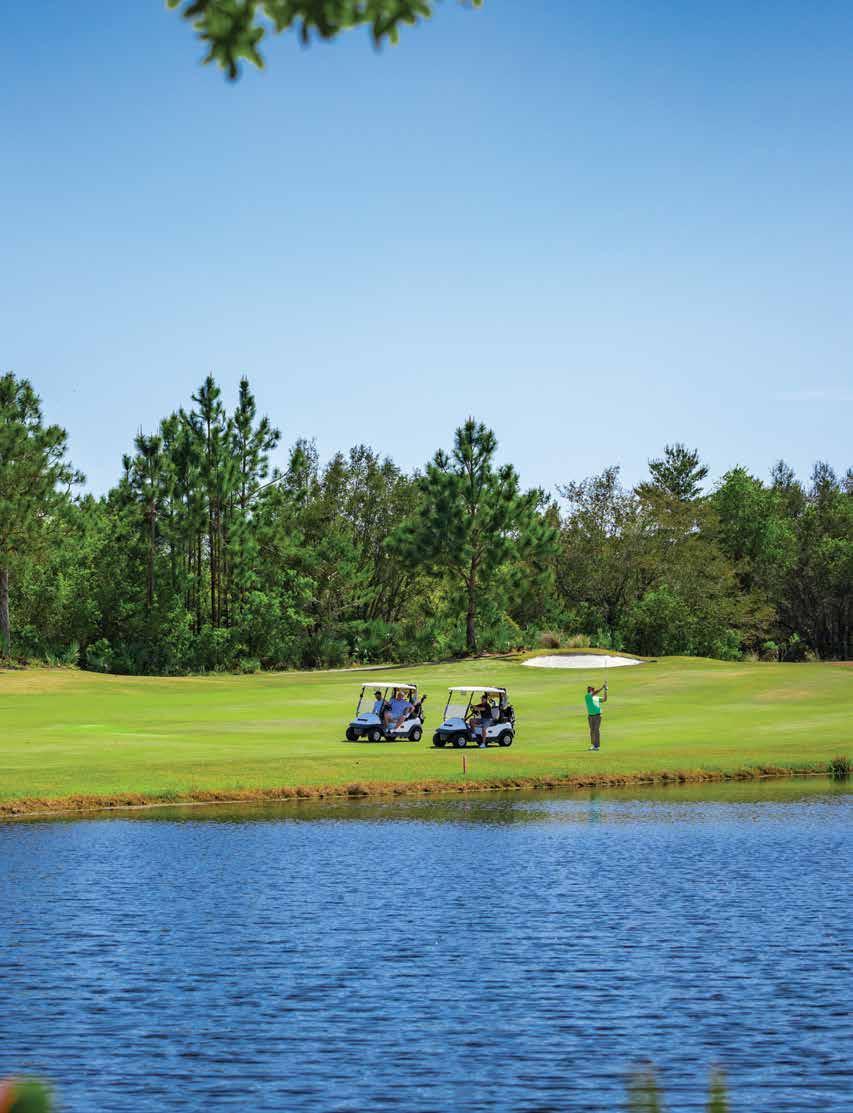
You’ve played the course, now you can live on it.
AMBROSIA RESTAURANT AND PUBLIX ® SUPERMARKET NOW OPEN + ADDITIONAL MERCHANTS OPENING SOON + YEAR ROUND EVENTS
Located at the entrance to the Watersound Origins® community.
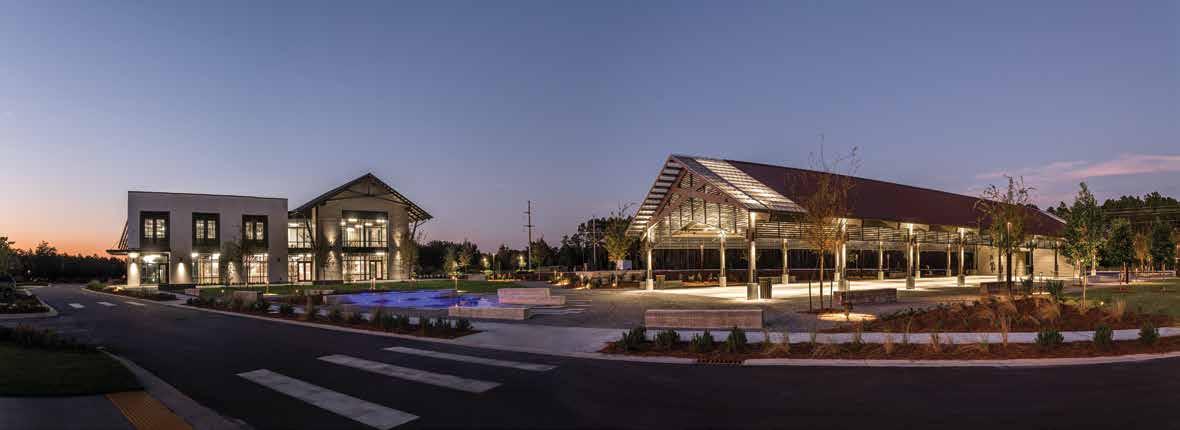
South Walton’s newest destination for shopping, dining, and entertainment. FOR
1.888.836.8353 watersoundtowncenter.com

DR. JON SCHMIDT brings the Emerald Coast to life as he educates fellow Members on the area's ecology and abundant life.

Dr. Jon Schmidt has been teaching a popular Coastal Ecology class on Saturdays at the Beach Club for the past five summers, treating all ages to a closer look at what makes our area just so special and unique. The class is a hit for attendees, but it’s clear that Schmidt takes great satisfaction in sharing his knowledge of and passion for the local environment. We were fortunate to get the chance to catch up with this Watersound Club Member to talk about the class and what he hopes his students will take away from the day’s lesson.
I grew up in the ’60s and ’70s, and I was enamored with Jacques Cousteau’s adventures. As a kid, growing up you either wanted to be an astronaut — because we watched people go to the moon — or you wanted to be an underwater explorer. I have a bachelor’s degree in marine biology and a master’s degree in marine biology, then I went to Florida State University and got a Ph.D. in biological sciences, with a focus on marine ecology. My major professor had a lot of research grants and supported seven grad students, which is fairly unusual. We did a lot of research in Apalachicola Bay, St. Joseph Bay and Apalachee Bay.
We joined the Beach Club in 2013, and we moved to the area full-time in early 2014. Going to the Beach Club I heard a lot of people talking and asking staff questions about the dune lakes and why they were important. People would ask, “Why don’t you just cut it open to the ocean?” So, I approached the Beach Club manager and offered to teach a couple classes, and they pretty quickly got to be very popular. The Club team asked me to teach more, so I did. The Watersound Club team bought

nets and sampling equipment, which meant that in the classes we could look at the water quality and collect samples in the coastal dune lake and in the Gulf of Mexico.
We start with a walking tour, beginning at the Beach Club. We talk about the dunes and the conservation area that The St. Joe Company has set aside. I ask a lot of questions to see what people in the class know and don’t know, and we talk about the birds that nest at the beaches, the different animals that live there and the invasive species. Then we walk down the boardwalk and we talk about the coastal dune lake and we take samples there. We do water quality sampling. We have seine nets and hand nets, and we look to see what
creatures we catch. We talk about how the fish and crabs have adapted to something that’s not saltwater. Then we go across to the Gulf side and do the same thing. We talk about sea turtle nesting, and I answer their questions.
I designed the class for kids, but I get adults, too. And they ask a lot of questions, which is good. For the kids, the most fun part is catching things. I’ve got some bigger gill nets, so we’ve caught larger marine life, like stingrays, and we caught a shark once. There are a lot of animals that come in and feed early in the morning, and then they go feed offshore and come back again at the end of the day. We’ve seen eagle rays, a manatee, sharks and sea turtles in the mornings. So we talk about that pattern of feeding and all the animals that live there. It’s a hands-on experience with the sampling and capturing of the
fish, and we identify all the different species we catch.
There are a lot of people who have been coming here for years and didn’t know much about the ecology of the area, but they are very curious.
I’m on the South Walton Turtle Watch board of directors and also conduct turtle nest surveys, so I can do a lot of explaining in that field, too. We get a lot of questions about turtles. So we help the kids understand why they should leave the beach the way they found it — fill in their holes, pick up plastic and that kind of thing.

The thing I like to teach the most is when we’ll catch fish in the coastal dune lake. Depending on if the outlet is open to the Gulf or not, I’ll identify
STUDENTS OF SCHMIDT'S COASTAL Ecology Class learn about the connection of area coastal dune lakes to the Gulf of Mexico and get hands on, catching creatures with seine nets and taking water samples.

the different species of fish and ask the students, “If you’re swimming in the water all day, what happens to your fingers?” And they’ll look down at their hands and answer, “They get all pruned up!” And to explain how that happens, we talk about osmosis and the fact that your skin cells are trying to balance the salinity in them by excreting water. So your skin shrivels up, basically. Now I ask, “Well, think about a fish. If a fish swims in freshwater all its life and all of a sudden there’s a big dose of saltwater, what would happen?” And we talk about the reverse: If a saltwater fish gets sucked into a dune lake what happens to it? And then we point out the species that have adapted to living in both environments, and you get to see the lightbulb going off in the student’s head. I like that part.
Or, catching something cool in the Gulf. If we catch a ray, or a shark or something big that they didn’t know was there, you can really see the excitement on their faces. There are times that we’ll run a seine net and get hundreds of fish in the net. And people have no idea all those fish are there along the shoreline! Those fish are eating in the surf zone because of all the animals that live in the sand. We’ll take sand cores, run them through the sieves and you’ll see the crabs, the worms and everything that lives there and attracts those fish. I just love helping people see and understand the connectedness of the environment. It gives them a little more appreciation for what’s all around us when we’re at the beach.
There are a lot of places in the world where there are lakes in the dunes, but most of those are catch basins for surface runoff. What makes the coastal dune lakes in Walton County so unique is that while they’re

also catch basins for the watershed that they reside in, they can get groundwaterfed or surface water-fed, they’re close to the Gulf and they periodically connect or flow into the Gulf of Mexico. When we get a lot of rain they’ll fill up to a certain point where the pressure at the beach causes it to blow out into the Gulf. Then you get something like a whitewater river of water from the lake rushing into the Gulf. Once the water levels reach equilibrium, then the Gulf’s wave action will build the sand back up and seal the outlet.
What that intermittent connection allows is for the animals that breed and live along the Gulf Coast, their young will live in those coastal dune lakes in the brackish water, and they’ll be allowed to grow without a lot of predation. When the outlet opens back up those juveniles will go back out into the Gulf of Mexico and grow up.

Coastal dune lakes are a very important nursery for blue crabs, redfish and a lot of the fishery species. They’re also important for the birds that nest in the dunes — particularly in the Watersound Beach area. The coastal dune lake outlets become an area where the parents bring their young to rear them. If you go down to the beach early in the morning, particularly in July and August, you’ll see adult terns with babies running up and down the outlet, and the parents are teaching them to feed and to fly. So those outlets become really important ecological areas for a lot of species.
The Camp Creek dune lake is unique because, even though it isn’t the largest coastal dune lake, it has the longest stretch of beach that the outlet could come out to. There’s more than a half-mile stretch of beach the outlet could migrate across. If you look at historical photos of the beach, from the 1940s to today, you’ll see that the outlet has migrated from the east end of the lake all the way west, beyond the Beach Club. What dictates where it goes is really driven by the buildup of the sand on the beach and how easy it is for an outlet to migrate to an area.

Starting three or four years ago, we started to get some really severe winter storms that dumped a lot of water. And with the wind patterns that we were getting out of the east, the outlet migrated west and also inland, starting to eat into the dunes and the conservation area. There’s been a loss of dune habitat because the outlet
COASTAL
offer young marine species protection from predation. An intermittent connection out to the Gulf releases them as they come into adulthood.
migrated, not only west, but north into the conservation area. We’ve held meetings with federal and state agencies, and they’re all in agreement that that area needs to be restored to put that habitat back in place. But Walton County has a land development code that basically excludes any work near coastal dune outlets, it doesn’t matter what the work is. We’re trying to lobby them to change that land-use development code to exclude everything but habitat rehabilitation, which is what this would be, but they haven’t made any progress on that yet. I think they’re concerned that it will get caught up with the customary-use battle.
Camp Creek Lake isn’t the only lake that has problems with the outlet migrating. Others have outlets near homes, and those outlets have migrated underneath a couple homes. So there’s pressure on the county
to reexamine that land-development code to allow some beach nourishment to help preserve the ecology.
WHY CAN’T WE JUST DIG A NEW OUTLET OURSELVES, OR BUILD A BRIDGE OVER THE EXISTING OUTLET?
As soon as man starts changing the environment, that’s when we ruin it. So if we dug a canal from the east side of Camp Creek Lake and had the outlet open year-round, then you’d basically ruin that lake. It would become brackish or saline, a lot of the freshwater fish that live in there would die, a lot of the nesting birds may stop nesting there, you could also get exotic species overtaking the vegetation that’s there. Once you change the environment it no longer serves the purpose it was designed for. All you have to do is look at what man has done to the Everglades and the billions of dollars they are trying to spend to put things back. Creating a saltwater pond would take away the nursery area for blue crabs, red fish, nesting birds and many other animals.
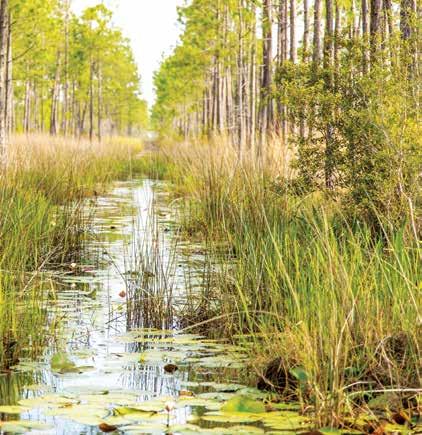
As far as installing a bridge or a structure, the state has what is called a “coastal construction control line” that runs along much of the coastline of Florida. It’s usually back near where the historic dunes are located. The reason they picked that is because of hurricanes. If you build forward of that line, you have to get special permission. They haven’t been allowing much construction seaward of that line lately because of the hurricane damage that’s occurred in a lot of communities. To put a bridge there would require a special permit. We’ve already talked with federal and state agencies, and they said they’re not going to allow that.
MANY PEOPLE HAVE QUESTIONS ABOUT SEASONAL SEAGRASSES AND ALGAE — IT CAN OFTEN BE UNPLEASANT. WHAT ARE THE DIFFERENT TYPES WE TYPICALLY SEE?

So, sargassum is a floating algae. I haven’t seen the levels change much in 30-plus years. Whether we have more on the beach or not is really determined by wind currents. When you have early storms in the season or wind patterns that blow up a lot of stuff from deep in the Gulf, then you get more sargassum washing up. But sargassum isn’t sticky, it’s not stinky and it’s a great habitat. A lot of animals live in the sargassum as it floats in the Gulf of Mexico. It provides habitat for many different fish species.
June grass is also naturally occurring. It’s a temperatureand nutrient-dependent blooming species. What that means is, if the water is shallow, it gets warm, and if it has the right nutrients it will explode in growth. When I moved here in 2014, I noticed a few times in August you would see quite a bit of this green algae in the water column. You didn’t see it wash up much, but you’d see it when you put your mask on or when you’re diving, as a green tint to the water. Lately, we’ve had very warm springs and early summers, and we have way more nutrient-rich
runoff than we ever used to have. So we had the right recipe last year — all the right conditions — and the algae just exploded. It’s called June grass, but normally you see it later in the summer, when the water is warmer.
How do you get rid of it? Normally you’d want to capture the stormwater and not let it run off into water bodies. Unfortunately, the runoff that goes into stormwater ponds here seeps into the sand. The Gulf and groundwater are connected, so that nutrient load gets into the Gulf. That’s more so the case in South Florida, which is why they get red tide so bad. Red tide is natural here, Spanish explorers even talked about it. But with the right temperature and right set of nutrients, it will explode in growth. North Florida doesn’t get red tide as much because we have quite a few rivers pushing the red tide offshore.
There’s also some seagrass offshore of Walton County, but not a whole lot. You’d have to go into the neighboring bays where the water is more protected to find it in abundance. There are some grass beds along the shoreline, but it’s in deeper water. So it’s harder to get to and harder to see. There are some beautiful seagrass beds in St. Joseph Bay, just phenomenal.
The best time to see marine life is early in the morning. I do our Coastal Ecology Class first thing in the morning. It’s the best time to see things moving along the shoreline. We’ve seen manatees, which do migrate over to Louisiana. That’s not common. But we’ll see sea turtles for sure, because the female sea turtles come back to nest where they were born. So you’ll see female sea turtles checking out the beach before they come back either that night or some night soon to lay their eggs. We’ve seen tarpon, we’ve seen a lot of sharks and also eagle rays as well as stingrays.
If you’re out at the beach at noon, you won’t see much marine life along the shoreline. But early in the morning and sometimes late in the afternoon, too, you can see quite a bit of marine life. Plus, the
birds — it’s common to see ospreys and pelicans hunting. You can see dolphins — I see them just about every morning that I do turtle surveys. But really what’s interesting is when you see a pod of dolphins swimming in a circle to round up the mullet or whatever they’re chasing, and then they go through one at a time. They’re vicious hunters by the way, they just tear up a school of fish. You can see that once in a while in the morning.
I usually end the class with a little bit of discussion about man’s impact on natural ecology. I can usually collect a bag full of washed up garbage in a short walk on the beach — most of it is plastic and mostly from people discarding stuff on the beach or into the Gulf — so we talk about that and about avoiding use of plastic bags and things like that.
Man’s impact has a lot to do with what’s happening in our marine environment — the algal growth we’ve had the past two years is probably the result of stormwater runoff. Impervious surface areas translate to more stormwater getting pumped into the Gulf of Mexico.
People often ask what they can do to help. If you want to be involved there are organizations like the Choctawhatchee
Basin Alliance, there are a lot of volunteer organizations that would welcome manpower or donations. As a member of South Walton Turtle Watch, we’re looking to get steady funding so that we can help the state do research. They rely on these turtle watch boards to do the lion’s share of the nest surveys and collect data to help them manage the species. So there are volunteer organizations like that where people can get involved. But really, just the simple act of picking up after yourself or picking up after someone else is a big help.
The biggest thing is just to leave the beach the way you found it. It makes a big difference because the plastic doesn’t go away — a piece of paper will dissolve to nothing over time, but plastics just become microplastics. It’s already showing up, not only in sea life, but also in human blood. It’s getting into our food chain. We don’t really know what that will mean for us yet. No one’s really studied what it means to eat plastic. But I imagine, in the long run, it’s not great.
You educate for stewardship. Without education people can’t be good stewards. But hopefully, if they learn, they can become good stewards. A lot of people are discovering this area and moving here. The more we can do individually to help protect the natural environment, the better it will stay.


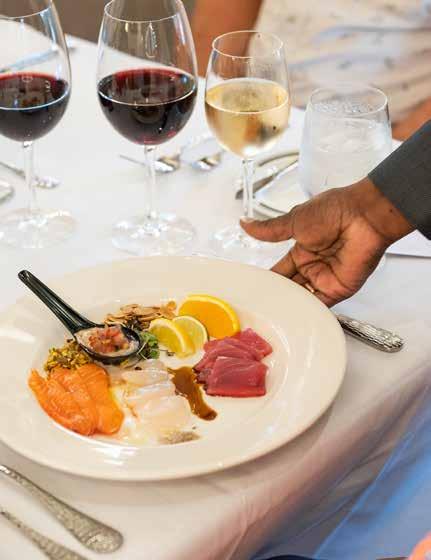




Golf is a lifetime sport, and many of the sport’s elite start early.
In fall 2021, Operation 36, a golf-instruction program that aims to help players grow from beginners to being able to shoot a score of 36 for nine holes, entered the scene at the Watersound Club Golf Performance Center to help imbue children with a lifelong love of golf through game-based activities. The eight-week program has since been offered in the spring, fall and winter.

As a nationally recognized golfinstructional program that teaches foundational skills of the game as well as larger concepts like honor and work ethic, Operation 36 has much more to offer than reaching a specific golf score. So, no matter the person’s age or size
Ben Blalock, director of golf instruction at Watersound Club Golf PerformanceCenter, starts them 25 yards away from the hole. They progress incrementally as they achieve their target score.
“The process of lengthening the hole each time continues until they’re playing on the regulation tees,” said Blalock.
While working toward a score of 36, the participants learn fundamental skills in a fun atmosphere where they’re awarded skill-mastery-achievement stickers to fill up their bag tags. During the eight-week semester, the topic for instruction changes each week.
“We spend 10 minutes on the fundamentals and the rest of the hour-long group session is game based,” said Blalock. “They practice the skill, but within the context of the game. There’s friendly competition and fun activities that tap into their imagination.”
Lessons center around key elements like posture, power, grip, ball flight, putting and green reading. Peripheral skills like fitness and nutrition are also touched on. Even interview confidence is brought in with Blalock videoing a short Q&A with participants after they achieve a new goal.
The curriculum includes two take-home written exams that students complete with their parents by the end of the semester. Blalock added, “Honor and mastery make up those exams and they cover things like rules of golf, etiquette, behavior, history of the game, and knowledge of how the game works. It helps them think about golf away from the golf course.”

Instruction happens at the Golf Performance Center one day per week, on either Thursday or Friday. Blalock also offers an optional structured practice every Saturday and Sunday where he and his assistant coach the players.
“They’re practicing, we’re helping,” he said.
On five Saturdays during the semester, a “play date” is scheduled where the students meet at Origins Golf Course,

We spend 10 minutes on the fundamentals and the rest of the hour-long group session is game based. They practice the skill, but within the context of the game. There’s friendly competition and fun activities that tap into their imagination.”
— Ben Blalock, Director of golf instruction at Watersound Club Golf Performance CenterDIRECTOR OF GOLF instruction Ben Blalock uses fun, interactive instruction to ease young players into the game.
STUDENTS OF Operation 36 meet at Origins Golf Course five times throughout the eight-week instruction, making strides toward their goal alongside Blalock.

the 10-hole Watersound Club course. This serves as a pseudo exam where participants try to make steady progress toward their goal. Blalock added, “At the end of each semester, we have a party with cake and ice cream, and the groups play as a team — we change up the lengths of the holes and give them opportunities to make holes-in-one; it’s more about having fun than being an end-of-semester exam.”
Often, classes have siblings of differing ability levels, but they all start at the same 25-yard mark and get the same foundational lessons. They hear the same concepts as a group, but then the older or more skilled player may get different information in the one-on-one breakouts, ensuring there is something enriching for everyone who participates.
Blalock cautioned that golf instruction should be easy and natural, not a source of frustration for players.

“The coach thinks they have a more skilled player, so they can give them more specific details; whereas with a beginner they make it simple,” Blalock explained. “We keep the message as straightforward as we can. In the one-on-one time, we may address a player’s more specific questions, but in the full-class lesson plan, the message remains clear and uncomplicated. You need to have clear intention and then work at achieving it, rather than getting lost in the details and losing the fun.”
It’s no secret that work ethic plays a big part in an athlete’s success. The team at Operation 36 created an
app to aid in tracking participants’ practice. Families download the app and log practice time.
“Each semester they need to log 10 practice sessions away from class, away from exam day,” said Blalock. “We want to instill that you can’t just come to class once a week and get better; you have to put in work on your own time.”
Blalock saw work ethic play out firsthand recently when a young girl, who attended previously, signed up again.
“She was stuck on that 25-yard distance. When she signed up this fall, I decided I would help her get over that hump — I don’t want her to think this is just too hard and quit golf,” said Blalock.
He stayed with her on exam days, coaching her on how to prepare for the shot. The first time she missed her goal by two. The next time she missed by one. The third time she passed it by two shots.
“It was a special moment for both of us when she conquered that distance. I hope we help all the kids realize that with enough commitment to a task, enough determination to keep working at it, you can do anything that you put your mind to”
That’s just one of the ways that Operation 36 develops lifelong skills beyond aptitude on the green.
Now, the Watersound Club instruction team is also offering the Operation 36 instructional model to ladies who either used to play or are just getting started. It works on the same premise as with the junior players, with simple, clear direction and incremental progression. Plus, cake and ice cream, the cherry on top of the tee.
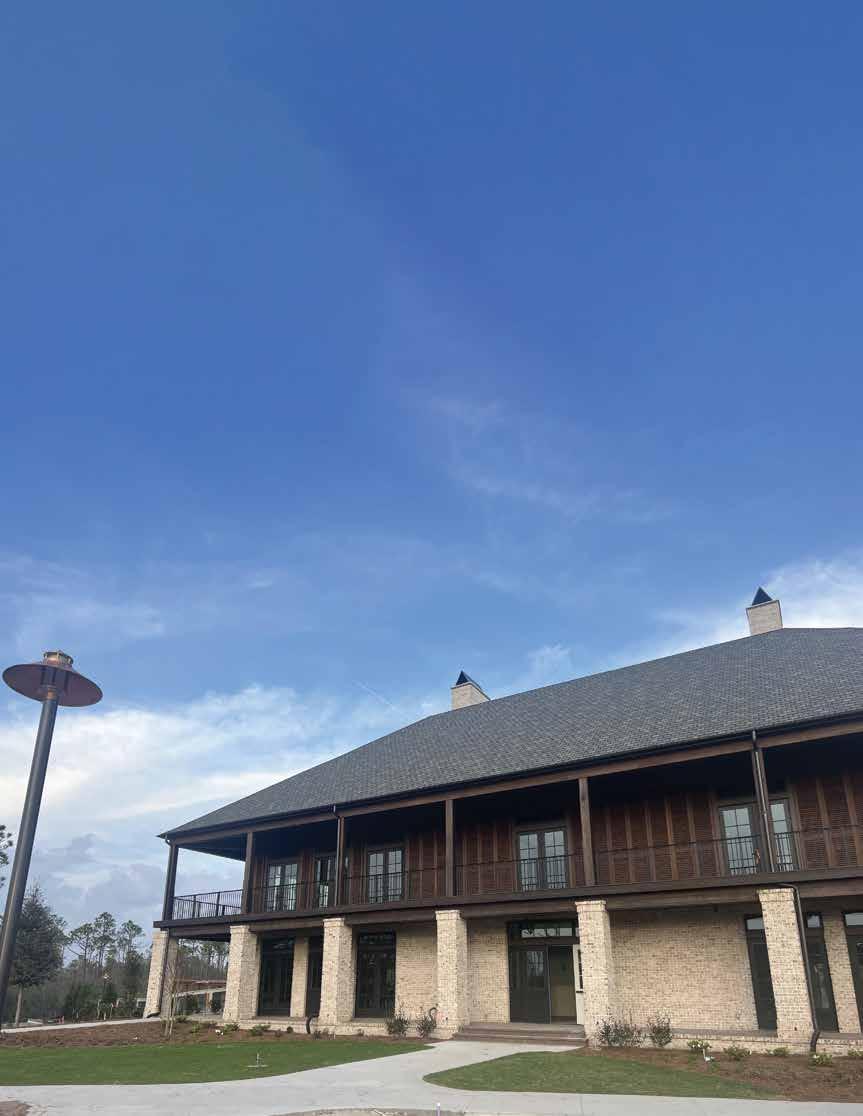


Private air charters take Watersound
Club Members into the wild, blue yonder

Watersound Club Members are reaching new heights and arriving at their destinations in comfort and style aboard a sleek and efficient Pilatus PC-12 NG charter aircraft. While many of our Members have experienced the pleasures of private air charters firsthand, others may be waiting for the perfect opportunity to climb aboard. To help brainstorm the best trips for Watersound Club Members, be they first-timers aboard a private charter or experienced flyers, we sat down with Watersound Club’s director of membership, Vicki Burris, and membership amenities manager, Jennie Frey, to discuss some of the many wonderful ways that our Members are making use of this unique amenity to create memories with friends and family, and make air travel something to look forward to again.
TELL ME ABOUT HOW UNIQUE THIS IS AS FAR AS A PRIVATE CLUB AMENITY. WHAT MAKES THE EXPERIENCE OF PRIVATE AIR TRAVEL SO GREAT?


Vicki Burris, Watersound Club Director of Membership:
I’ve never heard of another private club offering their members the option of private air travel. Clubs often talk about having sparkly pools, vast golf courses and beautiful dining rooms, but I’ve worked at five highend private clubs over my career and I’ve never heard of any other Club providing access to private flying, so we’re unique in offering that amenity to our Members. It’s a very cool concept to begin with, and obviously it provides a huge convenience factor that makes any trip that much more pleasant. Instead of waiting in lines and traveling on someone else’s timeline, Watersound Club Members are able customize their flight. They can drive right up to the private hangar, bring their pups, bring their kiddos. It makes air travel much more convenient and enjoyable.
Jennie Frey, Watersound Club Membership Amenities Manager: Most of our Members use the Pilatus for vacations. It always picks up for holiday travel and anytime that school is out, but we do host a fair amount of business travel as well. Alabama football games have already booked for the 2023 season! Orlando is a popular destination — it’s a short flight, so our Members often take their children aboard the Pilatus for quick trips to Disney World.
Nashville is a lot of fun and well within our flight range. The Bahamas are not too far away. Atlanta is another fun spot. Dallas, Houston, Louisiana, of course, and Miami. All of those destinations have been popular with our Members. We visited the Hamptons for the very first time this year and that was a great trip. Asheville, North Carolina, in the fall when the leaves are changing is incredible — we have Members who
fly up just to see the fall foliage. Golf trips to play other great courses are a popular option — we’ve even had Members who chartered a flight to play golf in South Florida when the weather forecast here would have otherwise kept them off the course!

VB: We’d love to help more Members get involved in our private air charter amenity. Many of them have heard good things from others who’ve gone on a trip, but aren’t sure exactly when or where they’d like to fly. What we want to do in the coming year is to be able to present our Members with a really cool travel opportunity — we will handle all the arrangements for them, so it will be fun and make it easy to say, ‘Yes, sign me up.” We will coordinate the flights, ground transportation, meals, tickets to an event, and everything else is arranged at your request for you and your
friends and family, so that all you have to do is show up at the hangar and hop on the plane.
Not only will that make taking a fun trip easy, but because the aircraft can accommodate up to eight passengers, maybe this will be an opportunity for Club Members to form new connections. What better way to meet and bond with fellow Members than during a cool trip on the Pilatus?
JF: That’s so true! Earlier this year our director of golf, Patrick Richardson, helped set up a golf outing to Streamsong — what would have been a seven-hour drive turned into a short one-hour flight. The preplanning and air travel made everything simple. The entire group had a great time, enjoyed dinners together and played three different golf courses while they were there. What was really just a trip that left on a Sunday and returned on a Wednesday, will end up being a trip they can remember for the rest of their lives.
These trips can create great bonds of friendship, too. In 2022, we flew several Members who had never met before to the National Championship game — there were two Georgia fans and the rest were Alabama fans. They all really enjoyed it and, to this day, those Members still meet up at the Beach Club and talk about their experience.
We’ve discussed the idea of organizing packaged trips with some of our Members, and we think that if we put together an all-inclusive travel experience at the Member’s request, it would take the work out of trip planning for our Members. The feedback we’re getting is that the idea is very appealing.
JF: They can definitely reach out to me, and we can put our heads together with the membership team and start planning additional details from there. You can email, call or text me to get the ball rolling.

THE CLUB'S PRIVATE AIR charter can accommodate up to eight passengers for all-inclusive trips coordinated by the Club at the Member’s request.
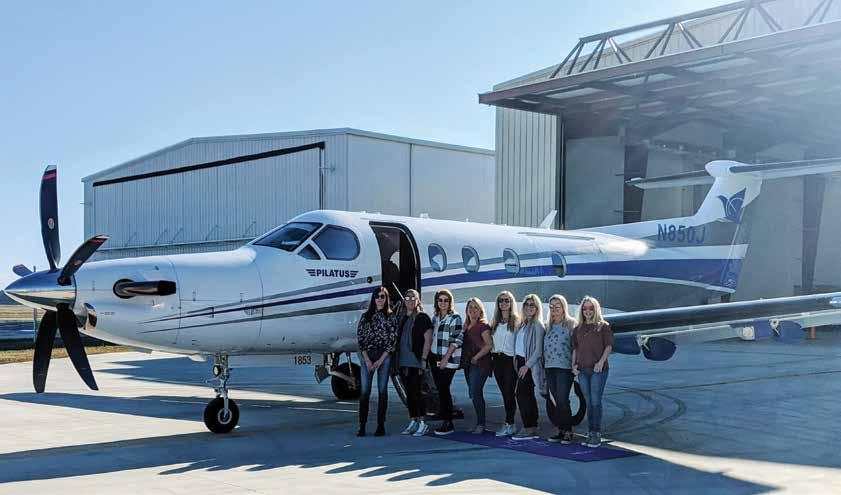

YERGERS take advantage of convenient
VB: If you wanted to recruit more Members to share the trip with, we can certainly reach out through the Member newsletter and our private social media pages. I can’t imagine that it would be difficult to find other Members interested in joining the trip.
WHERE SHOULD MEMBERS BE ON THE LOOKOUT FOR INFORMATION ON PACKAGED GROUP TRIPS?
VB: Check out the weekly e-newsletter, as well as the website, mobile app and social media. We’ll be sharing the details on those channels.
IS THERE ANYTHING ELSE IMPORTANT THAT CLUB MEMBERS SHOULD KNOW ABOUT PRIVATE CHARTERS ABOARD THE PILATUS?
JF: The beauty of private air charter is that we can customize it to fit your exact needs and specifications! Maybe that means just having more convenience
or flexibility when you travel, but that customization can also extend to special needs that you may have. The Pilatus is handicap accessible. So if a Member or one of their passengers has limitations with walking, we can get them in and out of the plane safely. I have some Members who are flying their 90-year-old parents down, and we worked with the airport to arrange a ramp and a method for them to load and unload right from the hangar.
Also, while the aircraft typically flies with one pilot, I want our Members to know that, upon request, we can arrange for two pilots to be aboard for their trips. That’s something more and more Members have expressed an interest in, and we’re happy to provide that service, too.
St. Joe Resort Operations, LLC, dba Watersound Club, arranges air transportation for active Club Members. All flights are flown as charters by Western Aircraft, Inc., dba WestAir Charter (“WestAir”) under 14 CFR Part 135. WestAir is the direct air carrier in operational control of the aircraft during all Member flights, and the Club acts as an indirect air carrier, air charter broker and agent of WestAir. Liability insurance covering the charterer, passengers and property on the charter flights is maintained by WestAir and not by the Club. Flights are subject to availability. Refer to WestAir’s Terms and Conditions of Transportation for Members of the Club. Membership is subject to the Membership Plan, the Membership Agreement and addendums thereto, the Rules and Regulations of the Club and any applicable community documents.






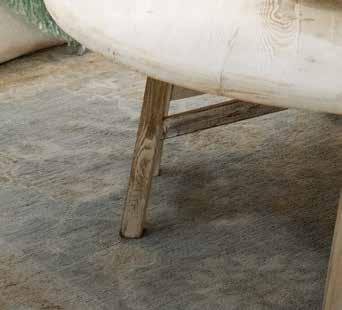




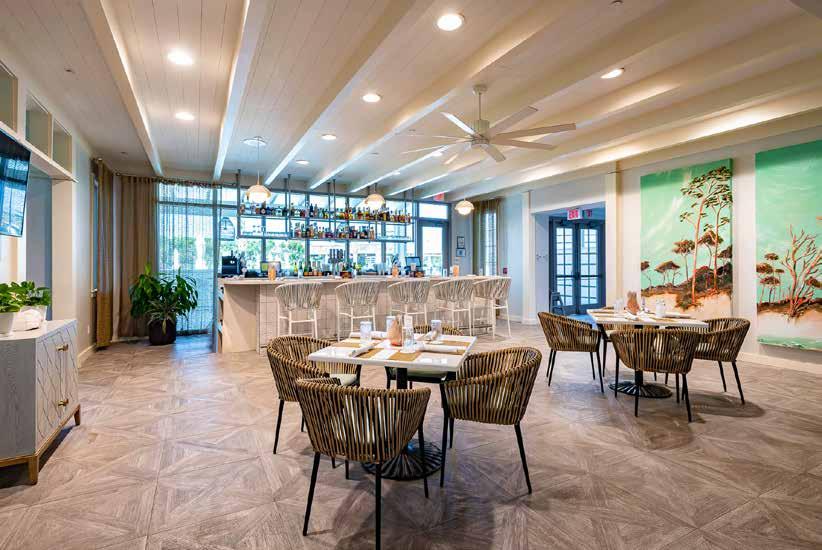 Written By CARRIE HONAKER
Written By CARRIE HONAKER
They say no great stories start over a salad, but at Gather Kitchen + Bar at WaterColor Inn, they often do. Gather has become a place where families and friends are communing and creating memories while enjoying signature cuisine. The luxurious, coastal-chic property reopened in June, 2022 with a completely renovated pool, decor by local artists and a bar that marries the inside to the outside, affording panoramic views of the emeraldgreen water and sparkly quartz sand.
Guests can enjoy the full menu poolside — everything comes on sturdy melamine dinnerware so there’s no danger of broken glass around the pool deck. This newest amenity to the WaterColor Inn experience is open exclusively to Watersound Club Lifestyle Members, their guests and guests of the hotel, giving Members another venue for making memories at the pool or over a great meal.
Another new addition is veteran chef Blaine Wilkinson who came to the restaurant
in April 2022 after spending 15 years working abroad. Cooking in restaurants since the tender age of 19, Wilkinson brings a breadth of knowledge to the eatery.

“I’m really proud of this menu because it incorporates many different elements of my travels,” said Wilkinson. “The lamb kofta comes from my time in the Middle East. I spent some time in China and that influence shows up in dishes like the snapper with the ginger soya broth. There’s a Boerewors sausage that recalls the five years I spent in Africa. It’s a popular African coiled sausage that we make in-house.”
Shareable appetizers, handhelds, boards and greens are available all the time, but from 5 p.m. until 9 p.m., family-style dishes join the menu. And no dish speaks more to Gather’s mission to provide a space to share a laid-back coastal lifestyle and enjoy elevated menu selections than the beercan roasted chicken.
Wilkinson elaborated, “The beer-can roasted chicken is designed to be shared. It’s a whole chicken roasted vertically on a beer-can rack with a beer inside, which makes it moist and flavorful. It would be a lot for one person, but is great divided up with friends and family.”
Wilkinson is a big fan of cheese and opts for one of the expansive boards when he and his wife dine at Gather. The grissini (Italian breadsticks) make the perfect foil for a selection of cheeses from around the world, fig jam, honeycomb and housemade pickles.

“We always order cheese when we go out and these boards are perfect to share,” said Wilkinson.
He also has a soft spot for the nacho fries. “I love Mexican food and always craved it throughout my travels. This is essentially a nachos-style plate of french fries. We hand-cut the potato wedges, bake them and then fry them in-house,” Wilkinson added. It doesn’t end there though — creamy pepper jack cheese sauce, sour cream, spicy tomato kachumbari (fresh tomato and onion salad popular in Kenya), cilantro, and chopped bacon are mounded on top of the crispy wedges.
Another signature appetizer hails from Wilkinson’s time in Qatar. Cooking at an elevated rooftop bar, Wilkinson developed a lobster corn dog. When he created the menu for Gather he wanted to include a variation that included some of the fresh Gulf seafood right in our backyard. That idea became the seafood corn dogs, a wildly popular menu item.
Wilkinson added that the hot chicken sandwich from the handhelds menu flies out of the kitchen as well, “Everything on that sandwich is done in-house and people love it.” I mean, it’s no secret, Southerners love fried chicken. And when you make it spicy, it’s a definite winner.
Chef Wilkinson’s adoration of the bone-in ribeye was palatable. The tender, cooked-to-your-liking cut of steak is served with bone marrow canoes that melt in your mouth. The bright, herby chimichurri sauce complements the rich marrow and soft-as-butter ribeye.
“It reminds me of osso buco,” he said. “The marrow is very soft and then you stir in some garlic or mustard … just the perfect accompaniment to the ribeye.”




Port St. Joe, Florida, is a town steeped in history, one that bustles in the spring and summer with visitors but always maintains a small-town feel.
This area, nestled along St. Joseph Bay, is home to a Constitution Convention museum, the historic Cape San Blas lighthouse, idyllic white-sand beaches of the Forgotten Coast and a marina that was completely demolished by Hurricane Michael in 2018.
“It’s a major landmark in a small town, and it’s a hub of activity for locals and visitors,” said Preston Sutter, general manager of the
newly rebuilt Point South Marina at Port St. Joe.
Reopening was never a question for The St. Joe Company, which worked tirelessly to rebuild the marina, aiming to reopen it better than ever.
The former Port St. Joe Marina began reopening in phases starting in the fall of 2022 under a new brand name, Point South Marina. Earlier, a sister marina at Bay Point in Bay County had reopened. It, too, had been rocked by Michael.
“Reopening restores an important piece of the heart of Port St. Joe,” Sutter said.

 THE REOPENING of Point South Marina at Port St. Joe restores a sense of community, serving as a hub for local and transient boaters.
THE REOPENING of Point South Marina at Port St. Joe restores a sense of community, serving as a hub for local and transient boaters.
The design of the newly rebuilt Point South Marina at Port St. Joe features 48 wet-boat slips, a 300-foot transient dock and the Point South Marina’s Outfitter Shop, where boaters can stock up on essentials ranging from cold beer, drinks and ice to Point South Marina merchandise and items from big brands like Yeti and Toadfish. Visitors will also enjoy state-of-theart updates like in-slip pump outs, plus widened slips, extended finger piers and laundry, bathroom and shower facilities.
But most notably, the rebuilt Port St. Joe marina boasts a new 63,000-square-foot dry-boat storage facility, modestly referred to as the boat barn. The barn’s 252 indoor boat slips can accommodate boats up to 45 feet in length.

“The layout is as different as it could be,” Sutter said. “We flipped the marina. We built more slips on the land than we built in the water this go around.”
Sutter said this move occurred due to the fact that boating trends have changed since the construction of the original marina, as people have become more interested in keeping their boats safe from the elements. Also, people have shifted their interests in the way they want to boat.
“I call it the Instagram effect,” Sutter said. “Everybody wants to get on the water, they want to take a picture that shows all their friends they were on the boat, they want to go scalloping, they want to catch a fish, they want to ride around, then they want to be done.”
Missing from that vision of an ideal day on the water? The extensive prep work and cleanup process. And that’s where Point South Marina’s dedicated staff helps to turn dreams into reality.
With the Boat Cloud app, boat owners can pre-schedule times to have their boat in the water. The app alerts the Point South Marina team, and they take care of everything.
“I want you to pull your car up, I want a dockhand to meet you at the side of your car with a dock cart to help you and your kids across the parking lot, walk you down to the dock to where your boat’s tied up, full of fuel, full of ice, ready to ride,” Sutter said. “We want you to enjoy the best parts of boating.”
And when boaters return to the marina, the team will be there for the
nitty-gritty — hosing the boat off, flushing the engine and returning it to safe quarters in the boat barn.
“The goal for our team is to take away as much peripheral boat ownership as we possibly can,” he said.
Additionally, Grander Marine has four service bays in the boat barn for on-site repair services, and Craft Clean Services is offering subscriptionbased detailing and washing.

“Y’all get to enjoy the fun part, which is watching your kids create memories on the water, and then we do the rest of it,” Sutter said.
“We are just laser-focused on making sure that your family gets to spend time outdoors together. That is why we’re here, and that is what we do.”
People have shifted their interests in the way they want to boat. I call it the Instagram effect. Everybody wants to get on the water, they want to take a picture that shows all their friends they were on the boat, they want to go scalloping, they want to catch a fish, they want to ride around, then they want to be done.”
“This is not transactional; it is relational,” he said, adding, “We’ll judge our success as a team based on how many Christmas cards are hanging on our fridge.”
The history, walkability and small, beach-town vibe of Port St. Joe appeals to day-trippers. But, just as much, the area calls to avid anglers and families in search of memorable on-the-water experiences.

“That’s what’s so cool about this area. There’s fishing, there’s scalloping, there’s tubing, skiing, you name it,” Sutter boasted. “The shelling, the natural flora and fauna of this part of the Panhandle is just incredible.”
Sutter envisions that the marina will become a hub for transient
boaters and a place where locals and tourists can come to set out for a day on the water.
The marina is home to Buena Vida pontoon rentals and Freedom Boat Club, which is offering boating memberships. Aquabear Adventures is on-site to host excursions, too.
“My hope for this place is that on a Friday afternoon, there’s 25 people down on the dock, coolers pulled up, somebody picking a guitar, watching the sun go down. I hope we’re roasting a bag of oysters or grilling a fish that somebody caught. Hanging out.”
Sutter plans to host a crawfish party to celebrate the marina’s reopening.
It’s safe to assume the marina’s break-room fridge will be filled with holiday cards in years to come.
 Written By PAIGE AIGRET
Written By PAIGE AIGRET
Pan-seared and matched with linguine, over a bed of rice and sauteed veggies or served up steamed on the half shell. Scallops. We all love to eat them, but how many can say they’ve participated in what Preston Sutter refers to as the “saltwater Easter egg hunt” of hand-fishing them yourself?
Sutter, the general manager of Point South Marina at Port St. Joe, has been roaming local waters since his early teens.
“The boating bug bit me early,” he said. “I spent a lot of time at this marina when I was a fishing guide, hiding out from thunderstorms, bringing my family over here to scallop and fish.”
And he knows that St. Joseph Bay is a hotbed for scalloping, making Point South Marina the perfect launching point for those underwater Easter egg hunts.
“The back of the bay is just a lush pasture of turtle grass,” Sutter said. “It’s incredible how clear the water is and how lush and vibrant the sea grasses are in the back of this bay.”
While most of the bays in the area are river-fed, St. Joseph Bay has no freshwater influx, creating its unique clarity.
In waters of up to about five feet, snorkelers look for the scallops’ rows of blue eyes and then add them to their catch bags. Regulations allow for up to two gallons of whole bay scallops per person during scallop season.
“It’s an incredible way to spend a day on our bay,” Sutter said.
Some scallop from kayaks or boats. Others simply wade in. You can also opt for a guided excursion out of Point South Marina with Aquabear Adventures.
“It’s social. People tie up together, spend the whole day together and come home and grill out that night,” Sutter said.
“But you have to put SPF 5,000 on their backs,” Sutter said of kids spending hours staring into the water. So, don’t forget the sunscreen!
We offer travelers an incomparable guest journey—from seamless browsing and booking to easy check-in and the transcendent experience of a luxury vacation on the Emerald Coast.
We offer homeowners peace of mind with exemplary home care. Whether you’re looking to maximize revenue from season to season or to elevate the level of maintenance and attention your home receives in our challenging maritime environment, we are here for you. The Home You Love. The Company You Trust.
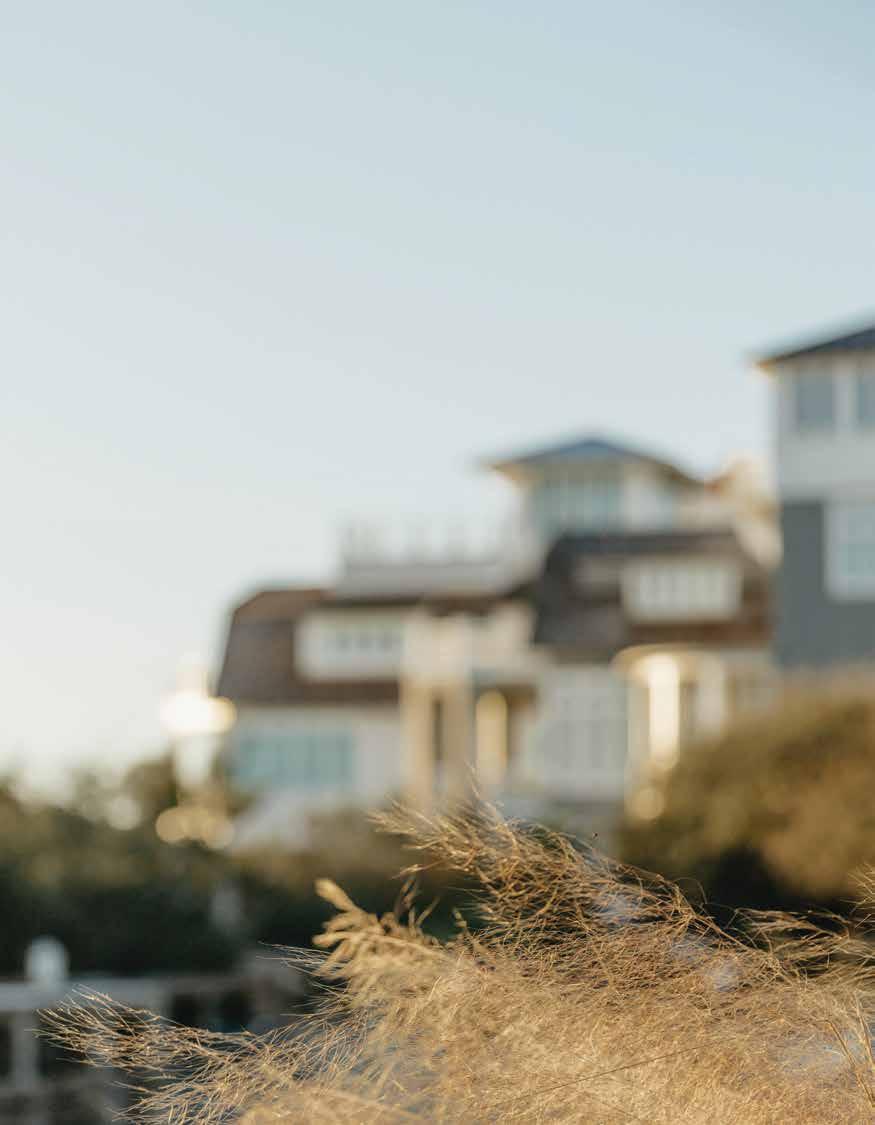
GOLF
TIPS FROM
Learn to control your full-swing shots with these tips
 Written By BEN BLALOCK
Written By BEN BLALOCK
Controlling the direction of your full-swing shots is both simple and complex, as, unfortunately, the golf swing itself is a puzzle that is difficult to solve. To be successful every time, we must possess two major qualities:

A clear concept upon which to operate.
Enough experience within that concept to be prepared for the events that occur during the swing.
When you play a shot, what touches the ball? Do you
physically touch the ball with any part of your body, or is it the club face?
The questions posed above might seem simple enough, and the answer is obviously the club face. So it should be similarly obvious that in order to control the direction your shots travel, you need to be able to control the club face. So, let’s first focus on the things that you can control to influence the direction of your shot.
Grip.
Ball Position.
Arm Motion.
Body Motion.
GRIP:
LEAD (TOP) HAND:
Place the club in the fingers of your leading hand (left hand for right-handed players, right hand for left-handed players) rather than in your palm, below the base of your fingers. Imagine picking up a heavy suitcase by the handle while standing next to it. You would grip it at the middle of your fingers, wrapping the tips of your fingers underneath the handle. This is the same place within your hand that the golf club rests. A quick check for correctness is to make sure you cannot see the fingertips of this hand as you hold the club.
While holding the club in the lead hand, place the lifeline of the trail hand against the thumb of the lead hand. The fingers of this hand should curl underneath and around the lower portion of the club’s handle. Again, the fingertips of this hand should not be in plain view.
The last finger of this hand needs to find a comfortable interaction with the index finger of the top hand. The pinky can be overlapped on top, the fingers can be intertwined with each other or the pinky can simply be placed on the handle itself. This choice is a matter of preference and is yours to make.
With the hands placed as described, they can work together during the swing rather than in opposition. As they do so, the club face will need to move naturally during the swing. It must be able to freely “open,” or rotate, as it is moved away from the ball during the backswing, and then to freely “close” as it is moved toward the ball during the downswing, rotating in the opposite direction to what it did during the backswing. It is much like opening and closing a door, hence the choice of words.
It is important to understand that these motions are entirely natural and are in no way contrived. Contrivance leads to inconsistency and requires constant management of the movement. This would be akin to thinking of every detail required when walking so that you can walk around without crashing into stationary things. While it may be possible, there’s simply no need for it. Similarly, in the golf swing, there is no manual twisting of the club face required in order to properly control it, just the simple, natural movement of the club away from the ball and then back toward it, coupled with trust in the fact that it will behave properly.
While this sounds easy enough so far, we must understand the primary challenge encountered by those who struggle in this department: The lure of the “target.” In this game, instincts are often misleading. In lessons, I frequently ask students, “Where is your target?” Almost invariably, the student will motion toward a flagstick, or a green that is far off in the distance, ignoring the
fact that during the swing, they will at no point physically touch that thing out in the distance. When the student is subsequently asked, “What will your club touch when you swing?” they realize that the actual target is the ball itself.


It is the responsibility of the golfer to cause the club to strike the ball, and it is the club’s duty to direct the ball toward its destination. Keep these relationships clear as you practice and play, and things can become surprisingly easier for you. Trust the club face to rotate correctly and you will soon be on your way to straighter shots.
This term refers to where the ball sits on the ground in comparison to your feet. When playing a shot from the ground — as opposed to on a tee peg — the back edge of the ball should be aligned an equal distance from each foot.
If the ball is closer to your lead foot (the one closer to your endpoint), the tendency is for the shot to either fly to the left of the endpoint (a “pull”) or for the shot to begin its flight left of the endpoint and end up turning in flight, eventually landing to the right of the endpoint (a “slice”).
If the ball is closer to your trail foot (the one further from your endpoint), the tendency is for the shot to either fly to the right of the endpoint (a “push”) or for the shot to begin its flight right of the endpoint and end up turning in flight, eventually landing to the left of the endpoint (a “hook”).
As you move from shorter-length clubs to longer-length clubs, this recommended ball position remains unchanged in the left to right way, but the golfer must stand further from the ball. In other words, it gets further from you but doesn’t move any amount left or right.
We must move our arms to make the swing. After all, the club is in your hands which sit at the end of your arms. Think about it like this: You could stand to the shot, leave the club head resting on the ground behind the ball and twist your hips clockwise then counterclockwise, and the club head will not move at all. So it’s easy to understand that your arms have to move when you swing the club properly.
Don’t make it too complicated, though — it’s a natural movement. All we do is swing the hands away from their starting point: Back, then in and, finally, upward, eventually placing them somewhere above the trail side shoulder. As you do so, you will be actively using the joints of the shoulders, elbows and wrists. Don’t overthink it, trust it!
Once the backswing, or windup phase, is complete, the momentum of this movement must be allowed to dissipate before reversing the movement. When you do so, you’ll feel things settle. It’s not a pause or a stopping of the motion, but instead it is a collection of the momentum in the backward direction. At the point in the motion at which you must begin the downswing, or the unwinding phase, you must have a clear idea of how to begin it. The downswing is a direct reversal of the backswing. The hands now move downward, then out and, finally, forward. Doing so requires only a shortlived burst of effort in the downward direction, the rest will happen naturally — if you allow it!
A correct grip, combined with your trust that the club will move, will put you in the best position for you. Not necessarily for anyone else — but you have to be yourself, you don’t have a choice! Although you may be tempted to mimic another player, doing so will lead you to the eventual realization that, while you may admire another player’s swing, you will never become that person. The sooner you realize this fact, the sooner you can begin playing a better game.
As mentioned above, the arms create the movement of the club. Likewise, the arms create the movement of the body — not the other way around! The body serves in a supporting role, providing balance and posture, never attempting to provide movement or control over the speed of the movement. You pivot because you swing your arms! The less you attempt to consciously control the details of the pivot, the sooner you will do it in the best possible way for your own body and its capabilities. As mentioned before, we need to trust that our coordination system will get the details right.
Grip the club in the fingers of both hands.
Place the ball equidistant from each foot.
During the backswing your arms go: back, in, up.
During the downswing your arms go: down, out, forward.
Your body supports motion, rather than drives motion.
BLALOCK SAYS to avoid mimicking the swing of other players. Trust the club and trust yourself.
Practice regularly for short intervals. Daily is best, but keep the sessions limited to 30 minutes at a time and judge yourself based on your ability level. “Straight” is a relative term, right? If you’re a skilled player, you will have a higher standard than a beginner might. If you’re a beginner, be lenient with yourself and develop your skill over a period of months — it takes time. Almost all great players are immersed in the game as children and develop their skill over years of trial and errorbased learning, often with limited or infrequent guidance that ignores details in favor of a simple message.
You now have the answers that you need to get better, it’s up to you to put in the time to learn how to make them work!
NEXT MONTH: USING THE DRIVER
Ben Blalock is certified as a PGA Master Professional, a GRAA Top 100 Growth of the Game Teaching Professional and serves as Director of Watersound Club Golf Instruction.

They say, “practice makes perfect,” and that statement definitely holds true on the tennis court. Proper repetition leads to confidence and success. You learn that the only way to do it is the right way. Situational drills reinforce good habits and help bring about winning results.
Let’s break down some of the different scenarios covered for game improvement.
Utilizing deep drives, drop shots and lobs will help to keep your opponents off balance.
Recognizing when to hit angles and down-the-line shots will help to limit your unforced errors.
Mixing up your serve location and varying your return will keep the other team guessing.
Benefits of live-ball play also include building a knowledge of when you are in an offensive or defensive stage during each point. Court positioning and coverage responsibilities will also become understood as the ball changes directions. Communication with your partner is another crucial component developed through these competitive practices.
Doubles drills are available as open groups and as small groups. Open groups can be attended as an individual or team and are offered weekly. Small groups consist of four to six players and can be scheduled at your preferred day and time.
You may contact me via email at Barry. Webb@stjoe.com to register for open groups or to schedule your own small group. I look forward to seeing you on the court soon!
Barry Webb is a USPTA and PTR Certified Tennis Professional who serves as Director of Watersound Club Tennis.


Everything you love all in one place! ®



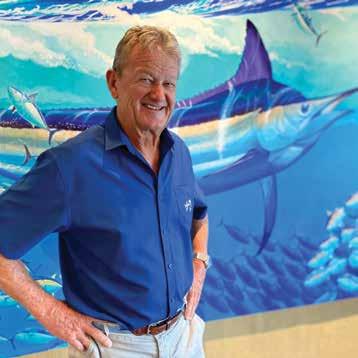 Written By CARRIE HONAKER
Photo Courtesy Of THE GUY HARVEY OCEAN FOUNDATION
Written By CARRIE HONAKER
Photo Courtesy Of THE GUY HARVEY OCEAN FOUNDATION

Erin Brack, a West Bay Elementary School K–5 STEAM Teacher, opens the treasure chest and removes a set of shark teeth. The anticipation in the classroom is palpable.
Today her K–5 students will make inferences about what prey sharks eat, their hunting strategies and what type of shark these belong to as they observe and touch the teeth.
do a stargazing activity and roast s’mores over an open fire.
The next day teachers left with all the resources needed to bring their learning back to their students, including a treasure box of goodies like shark teeth.
SJCF awarded a $99,500 grant to GHF to cover the funding, and GHF brought their curriculum and trainers to make this first round of professional training for teachers possible.
Created in 1999, “The St. Joe Community Foundation aims to support local nonprofits that work to make life better in their communities by focusing on education, environmental stewardship, cultural arts and building healthy communities,” said SJCF’s executive director, April Wilkes. “The Guy Harvey Foundation touches on many of our key pillars, and we’re proud to be a part of the good work they do here in Northwest Florida.”
“The St. Joe Community Foundation aims to support local nonprofits that work to make life better in their communities by focusing on education, environmental stewardship, cultural arts and building healthy communities. The Guy Harvey Foundation touches on many of our key pillars, and we’re proud to be a part of the good work they do here in Northwest Florida.”
— April Wilkes, SJCF’s Executive Director
Then comes the real fun — students make molds of their own teeth, read the book “What if You Had Animal Teeth?” and create a portrait of what they would look like with shark teeth. They move through the five E’s (engage, explore, explain, elaborate and evaluate), completing a STEAM (science, technology, engineering, art and math) art project embedded with academic instruction, thanks to funding from The St. Joe Community Foundation (SJCF) and training from the Guy Harvey Foundation (GHF).
Bay District school teachers like Brack participated in professional development to help them promote marine biology in schools at spots like the E.O. Wilson Biophilia Center in Freeport, Florida. Overnighting at the nature preserve allowed the teachers to get in the water with hands-on activities guided by GHF trainers, learning content to take back to their classrooms. In addition to the incredible professional development, the teachers had the opportunity to take nature hikes,
SJCF’s commitment to making life better in Northwest Florida aligns with GHF’s mission to inspire the next generation of ocean stewards to learn about the real-world issues facing different marine animals and environments and become champions of the ocean.

“At the Guy Harvey Foundation, we are committed to education, and that’s why we were so excited to roll out our curriculum throughout Florida and beyond,” said GHF’s co-chair, Jessica Harvey.
“It is critically important to inform, educate and engage young students on the importance of preserving our oceans and marine life. Through the educational initiatives we’ve launched, students learn about the world’s environment and wildlife. They come away with a better understanding of how they can help us preserve our ecosystems for future generations.”
Betty Bergnes, director of education and outreach for GHF added, “When you
can find partners like the SJCF who provides the funding, Guy Harvey that provides engaging, enriching content, and a group of educators that want to take this back to their classroom — an impactful synergy happens. We are looking forward to continuing that success in the coming year.”
Additional grants totaling $219,925 from SJCF in September 2022 will allow the program to grow and serve more Bay County teachers in 2023, and expand the program to include Walton County teachers and schools as well.
Brack, who helped write the curriculum, saw the impact of this partnership firsthand while visiting classrooms.
“Training would be on a Saturday, and I would be at their school on Wednesday of the next week,” she said. “They were already implementing what they learned. We have so many students who can’t express learning through a standardized, formal test. But if you allow them to show
it artistically, whether it’s writing a poem or drawing a picture, teachers can see how much they’ve grasped. This curriculum lets them do that.”
Across grade levels, students weighed shark teeth, created block prints of fish, painted watercolor migration charts and designed board games — all tied to the content related to the human environmental impact happening right in their backyard, not just in a textbook or video.
And the next round of training will emphasize adaptive learning.
“Our students are going to be the environmental stewards of tomorrow,” said Brack. “Every kid deserves to know, learn about and appreciate their local environment. And often, they go home and teach their parents, extending the reach of this project.”
Dr. Harvey’s passion for the arts, care for the ocean and dedication to education combined with SJCF’s drive to positively impact Northwest Florida, adds up to some pretty innovative learning going on in local classrooms.

ARTISTIC AND INTERACTIVE learning is encouraged as students write poems, paint watercolor migration charts and design board games.










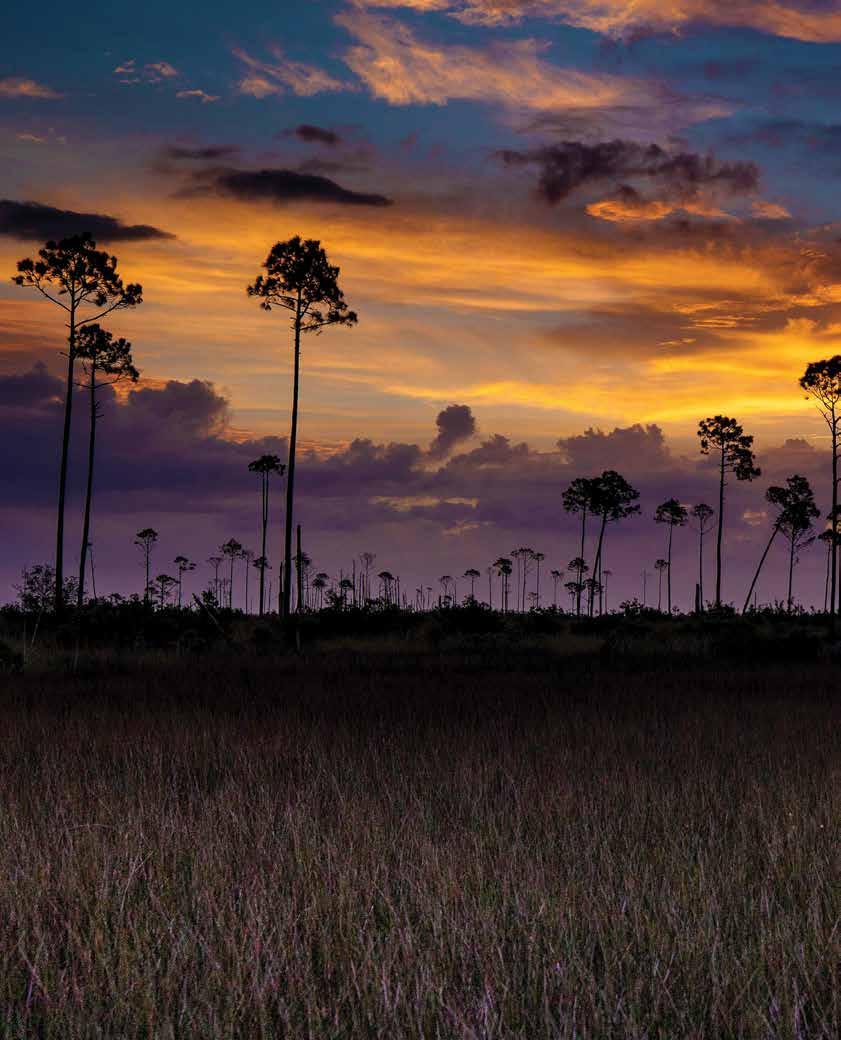
The St. Joe Company balances development with preservation, ensuring spaces where people can live amongst nature for generations to come
Written By CARRIE HONAKERWooded hiking trails, majestic blue herons gliding over lakes and the choir of bullfrogs serenading at sunset add to the beauty of the Northwest Florida landscape.

Just a short distance from the pristine Emerald Coast beaches that draw people from near and far sits thousands of acres of forested wonder waiting to be discovered. The balance between preserving that untouched world and building communities to enjoy it must be delicately observed as this area continues to grow.
When you think of real estate development, big corporate entities bulldozing the environment and setting up cranes usually come to mind. Thoughts don’t often turn to conservation and preservation.
But The St. Joe Company, established in 1936, proves that real estate developers can foster a shared interest in both building communities and protecting the lands that they are home to. It’s a shared interest which speaks to their core value — caring about the communities they work in with development that complements local ecosystems.
“We are believers in ‘The rising tide lifts all boats,’ expressed St. Joe president and CEO Jorge Gonzalez.
“We’re very community driven, and conservation of the environment and nature are very important components to the region and its future … it’s a very important component of what we do.”
Icarus Ecological Services, a natural resources and environmental consulting firm, works with St. Joe to provide innovative environmental solutions and create ecological restoration projects that balance regional ecosystem restoration with community development. With St. Joe’s 53,000 acres of conservation and restoration areas to maintain across Bay and Walton counties, an abundance of well-thought, longterm planning is required.
“Restoration is mainly focused on prescribed burning, vegetation management, invasive species control, native plantings and wetland restoration,” said Icarus senior ecologist Kelly Mandello. “This past year alone, the restoration team has planted over 65,000 native trees and grasses in Bay and Walton Counties.”









Many of those plantings are in longleaf pine forests, one of the most ecologically valuable and vulnerable habitats in the Southeast. Each tree sapling and tuft of native grass restored to the environment is planted by hand, a process that takes time and care. Over the next 50 years, those longleaf pines will grow 50 feet tall and be enjoyed by generations to come.
But planting is not the only effort employed by St. Joe. Prescribed burning — controlled fire in natural areas by certified burn crews — is used to reduce the risk of wildfires while reestablishing the fire-dependent natural ecosystems integral to Florida’s biodiversity.


“From an ecological restoration perspective, prescribed fire is one of the most effective tools we have for returning ecologically degraded land to a more natural state,” Mandello explained.
“Prescribed fire is truly like a paintbrush for ecological restoration. When you use it carefully, and time it during the right seasons, you can
see the change in a fire-suppressed ecosystem almost immediately. Woody vegetation is consumed and sunlight can peek through to the forest floor where it was crowded out before. The soil becomes newly invigorated with the ash and nutrients from the fire.”
While those forest floors appear charred and barren immediately after a burn, Mandello said that the results
come to life within days after, “when tender, new plant growth begins to peek up from the ground.” She also noted the observation of deer and gopher tortoises who enjoy grazing the fresh new grasses that sprout in the pine flatwoods and sandhills.
Many ecosystems in Florida are fire-dependent, but long-term fire suppression has hindered plant diversity. According to Mandello, grassy wetlands and hydric pine savannas are home to many rare plant species, and their survival is dependent on prescribed burns that help maintain their habitats. She added, “several imperiled wildlife species, including the protected flatwoods salamander and gopher tortoise, also require fires to thrive and succeed.”
In addition to prescribed fire, St. Joe restores natural hydrology to lands that have been altered by previous land uses and timber planting.
“We get a lot of rain in the Panhandle, and a nice, slow, natural sheet flow across a vegetatedsoil surface helps maintain water quality. Restoring natural hydrology is an effort to remove man-made flow channels and impediments in order to allow the water to move more naturally across the landscape,” said Mandello.
Nearly 20,000 acres in Bay and Walton counties are actively being restored in the form of wetland mitigation banks, reestablishing the ecology that existed before the properties went into forestry.

Efforts like prescribed fire and restoration of natural hydrology are part of St. Joe’s Ecosystem Management Agreement (EMA) with the State of Florida.
Of St. Joe’s 110,000 acres across Bay and Walton counties, 53,000 are designated for conservation efforts — that’s roughly five times the size of Manhattan. The framework of the EMA establishes conservation units that create wildlife corridors and wildland linkages between St. Andrew Bay and Choctawhatchee Bay.
“In the heart of the 53,000 acres is the protection of the entire shoreline of West Bay,” said Gonzalez.
Typically, residential developments only preserve wetland areas left after construction, but St. Joe’s EMA allows for long-term, large-scale planning that ensures linked wildlife corridors and forested spaces. Conservation easements — legally binding agreements that limit land development — protect property forever, promising that future generations will experience the area’s abundant natural resources.
Walkability is a chief consideration as St. Joe builds residential communities like RiverCamps on Crooked Creek — over 100 miles of trails connect activity centers with community centers and conservation areas. The natural areas attract many species of resident and migratory birds each year, creating an ornithological paradise for bird enthusiasts. Protected waters offer peaceful kayaking and abundant crabbing and fishing opportunities for the outdoor adventurer.
Under this plan, Mandello said that “the West Bay area will maintain spans of wildlands that traverse the landscape from bay to bay,” as new residential communities develop.
“We live here, and this is our home. This is where we’re raising our families,” Gonzalez added. “So, those concepts are important to us not just from a regulatory perspective, but from a stewardship perspective.”
“We get a lot of rain in the Panhandle, and a nice, slow, natural sheet flow across a vegetated-soil surface helps maintain water quality. Restoring natural hydrology is an effort to remove man-made flow channels and impediments in order to allow the water to move more naturally across the landscape.”
— Kelly Mandello, Icarus Senior Ecologist

Phones are forbidden. Grouper sandwiches don’t last long. Cocktails are knocked back. And Watersound Beach Club is packed with excited attendees.
It’s Trivia Night, presided over by Watersound Beach Club Director of Fun Andy Nelson, who quizzes participants on the many “things you should’ve learned in school had you been paying attention.”
Over three years, Nelson has become known as the Club’s “king of games.” A long career in recreation has prepared him for that role.
Nelson has been with The St. Joe Company for 11 years, starting out as camp manager at Watercolor Inn and Resort before working at its Beach Club and fitness center.

A transplant from Wisconsin, he’s worked in recreation since he was 17 years old.
“It’s something that comes very naturally to me,” Nelson said. “I’ve done it for 22 years now.”
He started out hosting local dodgeball and kickball games, trivia nights, stage shows and DJ parties in his hometown before working for 10 years at a Yogi Bear’s Jellystone Park Camp-Resort, overseeing activities and events.
In 2012, he was looking to move on from Wisconsin but wanted to remain working in events and entertainment. He applied for the position as camp manager at Watercolor Inn and Resort, and it wasn’t long before he had the job.
He was more than enthused to leave Midwestern winters behind for the sunny days and white-sand beaches of Florida’s Gulf Coast.
He currently oversees a number of kids’ activities, programs and craft times, as well as holiday events and scavenger hunts — all regularly on the calendar — plus a handful of other special events like themed dinners, bingo and sometimes poker nights.

But Trivia Night is a favorite, both for him and for Members.
“I’m a gigantic nerd at heart,” said Nelson, who prepares the trivia questions himself. “I have files and files and files of questions. My brain doesn’t really turn off when I go home.” He frequently watches the History Channel, news stations and game shows, always looking for ideas.
“It’s definitely fun being able to interact with the crowd on a minuteby-minute basis. Hearing the boos and hearing the cheers and the overall interaction with the crowd is all a part of our trivia nights,” he said.
Trivia Night occurs weekly at the Beach Club and sometimes at Shark’s Tooth Clubhouse and WaterColor Inn’s Gather Kitchen + Bar, too.
“Trivia, it’s a thing now,” Nelson is pleased to report.
And Members agree. The event started out with a crowd of about 30 people and has since grown to attract up to 300 Members some weeks.
“Some of our Members say, ‘We look forward to this because it’s a fun night out, and we can meet with our friends,’” said Nelson. “That’s the main thing, giving our members something to do. And they’ve kind of grabbed onto it and run with it.”
But it’s evident that the trivia questions aren’t the only draw.
While the good vibes, great food and satisfying cocktails certainly don’t hurt anything, the main attraction is Nelson himself, with a voice made for radio, an engaging energy that entices the crowd and, even on first introduction, an engaging manner that makes you feel like he’s an old friend.
Members easily bond with Nelson, who said at least a half dozen teams come on a regular basis.
“It’s really fun to be able to interact with the same teams,” he said.
Some give him a hard time. The “Day Drinkers,” a group of ladies who
attend regularly with their husbands, the “Designated Drivers,” enjoy engaging Nelson in banter.
Nelson, as someone who can easily laugh with others and at himself, is comfortable in front of a crowd.
“The best part is the daily interactions with our Members,” Nelson said. “I like to talk and always be entertaining somehow, whether it’s kids or adults.
“The kids are always excited to see you. It’s very rewarding to see the kids want to come and just be around you and hang out with you.”
While Nelson admits he wasn’t very sure what he wanted to be growing up, he “always thought being a teacher would be really great.”
Working in recreation has given him opportunities to connect with youth as both entertainer and mentor.
“You get to hang out with the kids, and you learn a lot about them,” he said. “When you have the parents coming and saying, ‘My son couldn’t wait to come and see you,’ it makes you feel good.”
It’s apparent that Nelson has a way of making Watersound Club Members feel good, too.
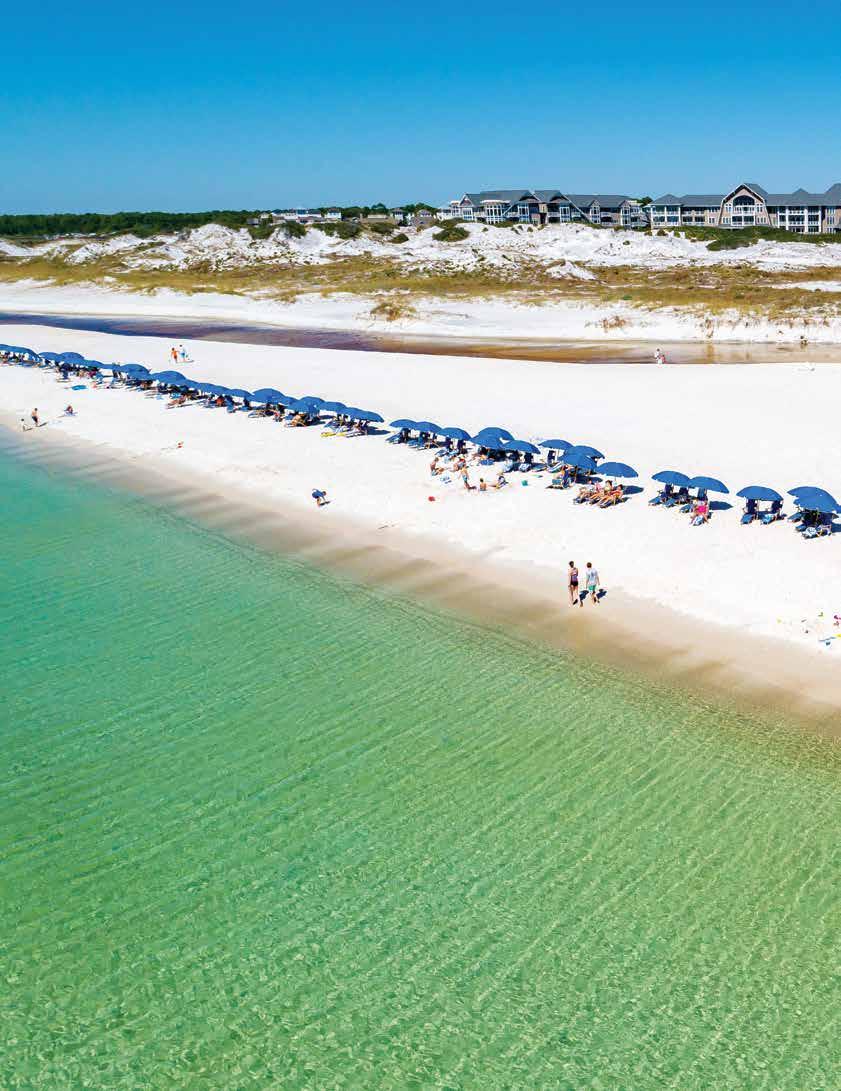




All
from 1 to

12
All items from 7 to 12 can be found at





Christian music singer-songwriter Chris Tomlin has over 7 million records sold worldwide and 25 years in the industry.

He’s a 15-time Grammy nominee with one win under his belt. And, in 2006, he became known as the nation’s most often-sung artist after a Time magazine article noted his songs to be the most popular across U.S. congregations.
His widespread popularity in churches across the globe gave rise to fame and a platform to share his beliefs, but at his core, he is a family man of faith.
“As his wife, I can say this,” said Lauren Tomlin. “Chris is a simple man. He’s pretty much middleof-the-road, simple as they come.”
She sees his simplicity as his best attribute and the reason for such a widespread response from millions of fans who sing his songs in church and, too, in moments of need.
“I think he has a way of framing things in a simple way where he’s not overly verbose,” Lauren said. “So I think that’s appealing on some level. People can sing it, and it’s relatable, and it resonates.”
Lauren and Chris live full-time in Franklin, Tennessee, with their three daughters, ages 11, 8 and 2, and spend holidays and breaks at their 30A home enjoying their Watersound Club membership.
Lauren noted that, at home, “a house full of girls keeps you busy and always running late.” And their Club membership brings tranquility and a break from their routine.
“The Watersound Beach Club experience is perfect for families … In a world that continues to get faster and faster, this is our place to slow it down,” said Chris, who plays about 60 to 70 shows a year.
But he always comes home for some semblance of a weekend and to spend time with family.
 OUTSIDE OF his Christian music fame, Chris Tomlin lives an unassuming, humble life with his wife Lauren and three daughters.
PHOTOS BY MANDY JOHNSON PHOTOGRAPHY
OUTSIDE OF his Christian music fame, Chris Tomlin lives an unassuming, humble life with his wife Lauren and three daughters.
PHOTOS BY MANDY JOHNSON PHOTOGRAPHY
And on a normal Tuesday, it’s back to simplicity — her running the kids to school and extracurriculars and him working something like a normal 9 to 5, in meetings or drafting new song material.
A quintessential American family.
“He’s kind of in that season where you want to balance work and family,” said Lauren. “So it’s that beautiful dance of being committed to what you love doing, but also equally as much wanting to be home. So we’re constantly working the calendar, working dates, trying to finesse things.”
And for them, finessing the calendar prioritizes those family vacations.
“That’s probably why we value so much getting down to the beach,” said Lauren. “It’s just kind of a space to carve out time.”
Lauren spent her childhood vacationing in the 30A area with her family. When she and Chris married in 2011, she knew she wanted that for their family, too.
“It was just the desire to start to create family rhythms with a getaway,” she explained. “To just keep some sense of perspective. I think there’s beauty in drawing away and unplugging, and it helps you keep your priorities in alignment. Time off has a way of solidifying what matters.”
The original driving force that brought them to become Watersound Club Members, though, was the sprawling golf courses.
“Chris loves the golf, has always loved the golf,” she said. “But then the pool and that experience, especially once they expanded, that became the crown jewel for the family.”
The lifestyle hit the beat they were searching for as a family unit.
“There’s something to be said about rhythms, that you know what you’re getting every time,” Lauren said of the Watersound Club membership. “There’s that familiarity.”
They know with every visit, they’ll be greeted by their favorite Beach Club server, Tommy, who’s been there as long as they can remember.
She appreciates the Club’s consistency in great service and likens the atmosphere to that of the “Cheers” TV show intro song, “where everybody knows your name.”
“There’s beauty in that. When life is moving fast, coming back to those familiar rhythms.”
In her 12 years of being a Watersound Club Member, Lauren said she’s never had as much as a hiccup in her experience.
“It’s an exceptional experience. Every time.”
Back home, Chris is gearing up for a tour on the heels of celebrating his 2023 Grammy nominations.

“He’s still full-on into music, loves what he’s about and doesn’t plan on packing it up any time soon,” Lauren said.
And she’s already finessing their calendars, both for time at the beach and for time to see their family man perform. She makes sure the girls get to experience their father on stage at least once every tour season.
“It helps remind the family of the bigger story of what we’re about,” she said.
And for the Tomlin family, what they’re about is the message Chris is spreading. The sold-out venues aren’t the reason but the response.

“Chris always says it speaks less about him and more about the church at large,” Lauren said.
“There are so many people that are leaning into God and wanting to sing music to Him. So it’s a reminder of the global response.”


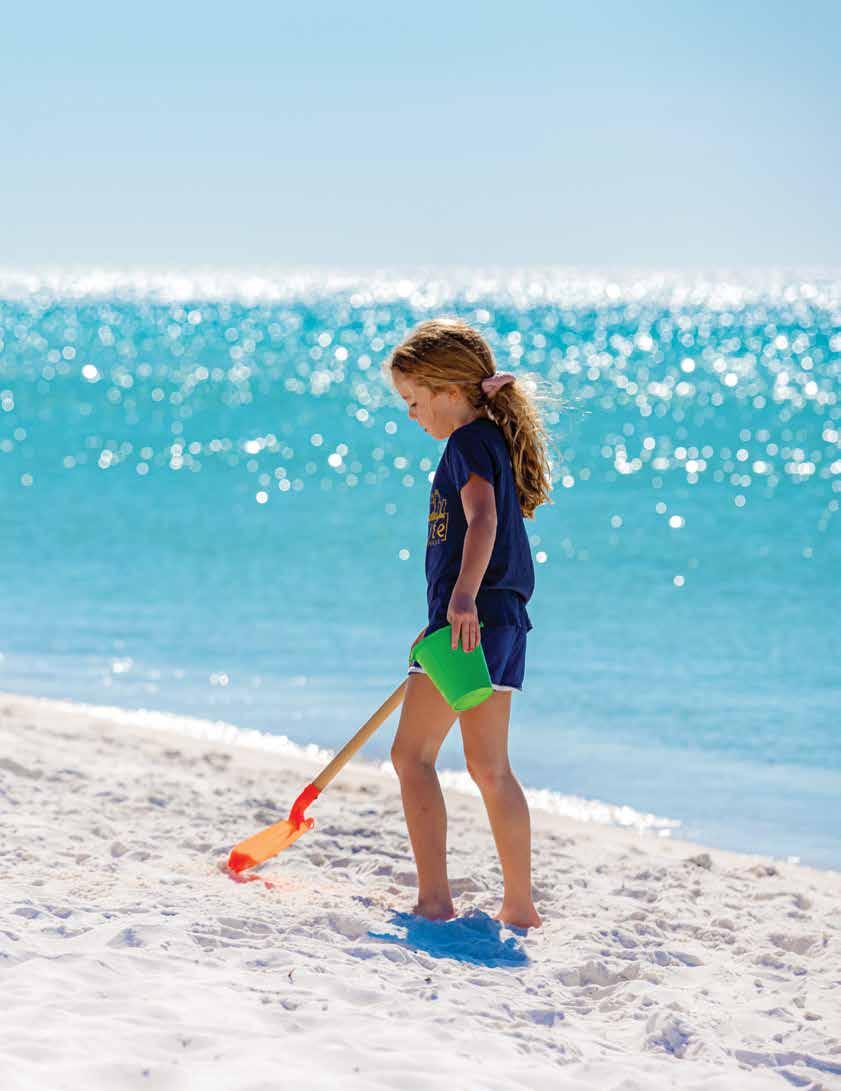
2023-2024
April 20–22, 2023
Watersound Club MemberMember Tournament
June 23–24, 2023
Watersound Club Championship
July 27–29, 2023
Norman-Fazio Classic
Sept. 21–23, 2023
Watersound Club Senior Member-Guest Tournament
Oct. 12, 2023
Watersound Ladies Invitational
Oct. 26–28, 2023
Sharkfest Member-Guest Tournament
March 15–17, 2024
Shootout at The Creek — Member-Guest Tournament
Visit Members.WatersoundClub.com to learn more about these events and other recurring events like trivia night, bingo, golf leagues and more.




Experience unlimited golf at Camp Creek and Shark’s Tooth courses, as well as access to Watersound Beach Club amenities. Find private air charter on the Watersound Club Pilatus PC-12 NG. You’ll enjoy fitness facilities, tennis and a robust calendar of social events throughout the year. Topping things off are a multitude of dining options and an extensive list of outdoor amenities the whole family will enjoy!
Visit WatersoundClub.com, call 850.213.5181 or email Membership@StJoe.com to start your application. Information in this Membership section provides a summary of the Watersound Club Membership program. As this information is only summary in nature, you should read the Membership Plan and Rules and Regulations for a complete understanding regarding Membership rights and privileges. Membership privileges and benefits are subject to change from time to time.





















